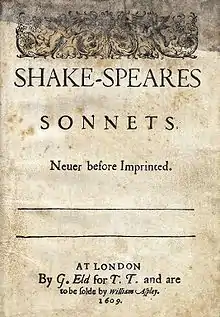Sonnet 2
Sonnet 2 is one of 154 sonnets written by the English playwright and poet William Shakespeare. It is a procreation sonnet within the Fair Youth sequence.
| Sonnet 2 | |||||||
|---|---|---|---|---|---|---|---|
 The first twelves lines of Sonnet 2 in the 1609 Quarto | |||||||
| |||||||
Structure
Sonnet 2 is an English or Shakespearean sonnet, which consists of three quatrains followed by a couplet. It follows the form's typical rhyme scheme: ABAB CDCD EFEF GG. Like all but one sonnet in the sequence, it is written in iambic pentameter, a type of poetic metre based on five pairs of metrically weak/strong syllabic positions:
× / × / × / × / × / How much more praise deserved thy beauty's use, (2.9)
- / = ictus, a metrically strong syllabic position. × = nonictus.
Analysis
Shakespeare's Sonnet 2 is the second procreation sonnet. It urges the young man to have a child and thereby protect himself from reproach by preserving his beauty against Time's destruction.
Sonnet 2 begins with a military siege metaphor, something that occurs often in sonnets and poetry — from Virgil (‘he ploughs the brow with furrows’) and Ovid (‘furrows which may plough your body will come already’) to Shakespeare's contemporary, Drayton, “The time-plow’d furrows in thy fairest field.” The image is used here as a metaphor for a wrinkled brow. Trenches are also carved into a field when a farmer plows, and the agricultural connotation is touched on two lines later with the image of worthless weeds.
Livery is usually a uniform for a butler or soldier, which may suggest that the young man's beauty does not belong to him.
In the second quatrain, it points out that when the young man is old and asked where his beauty went, and he must then answer that his treasure is found only in his own self-absorbed “deep sunken” eyes, it would be a shame.
The third quatrain suggests that this waste and shame could be avoided if the young man were to have a child who could inherit his beauty.[2]
Interpretations
- Caroline Blakiston, for the 2002 compilation album, When Love Speaks (EMI Classics)
References
- Pooler, C[harles] Knox, ed. (1918). The Works of Shakespeare: Sonnets. The Arden Shakespeare [1st series]. London: Methuen & Company. OCLC 4770201.
- Larsen, Kenneth. "Essays on Shakespeare's Sonnets". Sonnet 2. Retrieved 17 November 2014.
Further reading
- Baldwin, T. W. On the Literary Genetics of Shakspeare's Sonnets. Urbana: University of Illinois Press, 1950.
- Hubler, Edwin. The Sense of Shakespeare's Sonnets. Princeton: Princeton University Press, 1952.
- First edition and facsimile
- Shakespeare, William (1609). Shake-speares Sonnets: Never Before Imprinted. London: Thomas Thorpe.
- Lee, Sidney, ed. (1905). Shakespeares Sonnets: Being a reproduction in facsimile of the first edition. Oxford: Clarendon Press. OCLC 458829162.
- Variorum editions
- Alden, Raymond Macdonald, ed. (1916). The Sonnets of Shakespeare. Boston: Houghton Mifflin Company. OCLC 234756.
- Rollins, Hyder Edward, ed. (1944). A New Variorum Edition of Shakespeare: The Sonnets [2 Volumes]. Philadelphia: J. B. Lippincott & Co. OCLC 6028485.
- Modern critical editions
- Atkins, Carl D., ed. (2007). Shakespeare's Sonnets: With Three Hundred Years of Commentary. Madison: Fairleigh Dickinson University Press. ISBN 978-0-8386-4163-7. OCLC 86090499.
- Booth, Stephen, ed. (2000) [1st ed. 1977]. Shakespeare's Sonnets (Rev. ed.). New Haven: Yale Nota Bene. ISBN 0-300-01959-9. OCLC 2968040.
- Burrow, Colin, ed. (2002). The Complete Sonnets and Poems. The Oxford Shakespeare. Oxford: Oxford University Press. ISBN 978-0192819338. OCLC 48532938.
- Duncan-Jones, Katherine, ed. (2010) [1st ed. 1997]. Shakespeare's Sonnets. The Arden Shakespeare, Third Series (Rev. ed.). London: Bloomsbury. ISBN 978-1-4080-1797-5. OCLC 755065951.
- Evans, G. Blakemore, ed. (1996). The Sonnets. The New Cambridge Shakespeare. Cambridge: Cambridge University Press. ISBN 978-0521294034. OCLC 32272082.
- Kerrigan, John, ed. (1995) [1st ed. 1986]. The Sonnets ; and, A Lover's Complaint. New Penguin Shakespeare (Rev. ed.). Penguin Books. ISBN 0-14-070732-8. OCLC 15018446.
- Mowat, Barbara A.; Werstine, Paul, eds. (2006). Shakespeare's Sonnets & Poems. Folger Shakespeare Library. New York: Washington Square Press. ISBN 978-0743273282. OCLC 64594469.
- Orgel, Stephen, ed. (2001). The Sonnets. The Pelican Shakespeare (Rev. ed.). New York: Penguin Books. ISBN 978-0140714531. OCLC 46683809.
- Vendler, Helen, ed. (1997). The Art of Shakespeare's Sonnets. Cambridge, MA: The Belknap Press of Harvard University Press. ISBN 0-674-63712-7. OCLC 36806589.
External links
 Works related to Sonnet 2 at Wikisource
Works related to Sonnet 2 at Wikisource- An analysis of the sonnet
- An analysis and paraphrase of the sonnet
.png.webp)

